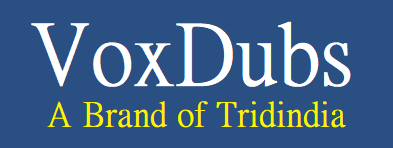In the world of audiovisual content localization, two common techniques are employed to make films, TV shows, videos, and other media accessible to diverse audiences: voice-over and dubbing.
While both methods involve replacing the original dialogue with a new one in a different language, they differ significantly in their execution and purpose.
In this blog, we will explore the differences between voice-over and dubbing and the contexts in which each technique is used.
Voice Over
1. Definition
Voice-over is a technique where a new audio track, featuring the translated dialogue or narration, is added to a video while keeping the original audio in the background.
The new dialogue is spoken by voice actors who are not visible on screen.
The voice-over artists’ voices are usually overlaid onto the original video, and viewers can hear both the original audio (often at a lower volume) and the translated voice-over.
2. Purpose
Voice-over is commonly used in documentaries, educational videos, interviews, news reports, and some types of content where the primary goal is to convey information rather than matching lip movements. It is an effective way to provide localized content without altering the visual aspects of the original production.
3. Advantages
● Cost-Effective: Voice-over is generally less expensive than dubbing because it doesn’t require extensive lip-syncing and post-production.
● Quick Turnaround: Voice-over can be completed relatively quickly, making it suitable for time-sensitive projects.
● Preserves Original Audio: By blending the translated audio with the original, voice-over allows viewers to hear the original voices and sounds, preserving the essence of the original production.
Dubbing
1. Definition
Dubbing involves completely replacing the original audio of a video with a new voice track in a different language.
The new dialogue is recorded by voice actors who carefully synchronize their speech with the lip movements of the original actors on screen.
The goal is to create an immersive viewing experience that matches the original visual performance.
2. Purpose
Dubbing is commonly used in films, TV series, animations, and other forms of entertainment content where the artistic and emotional aspects of the dialogue are crucial. It aims to provide a seamless and authentic viewing experience for audiences in different language regions.
3. Advantages
● Natural Lip-Sync: Accurate dubbing ensures that the translated dialogue matches the lip movements of the actors, creating a more natural and immersive experience.
● Cultural Adaptation: Dubbing allows for cultural adaptation, enabling jokes, idioms, and cultural references to resonate with the target audience.
● Enhanced Emotional Delivery: By employing talented voice actors, dubbing can effectively convey the emotions and nuances of the original performances.
Conclusion
In summary, voice-over and dubbing are both valuable techniques for making audiovisual content accessible to global audiences.
Reliable Voice over is cost-effective and suitable for informational content, whereas dubbing excels in providing an authentic and emotionally engaging experience for entertainment-based media.
The choice between voice-over and dubbing depends on the content type, budget, target audience, and the desired level of immersion.
By understanding the differences between these localization methods, content creators can make informed decisions to bridge linguistic barriers and share their stories with diverse audiences worldwide.
For more information contact VoxDubs at +91-8527599201 or grab an instant quote.
